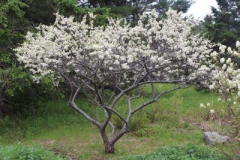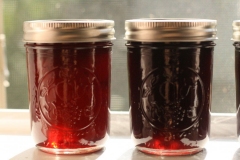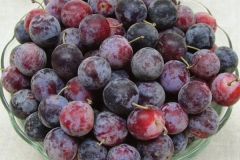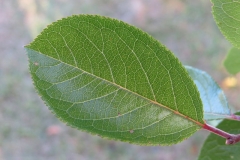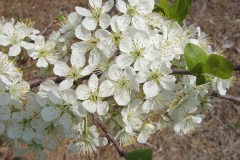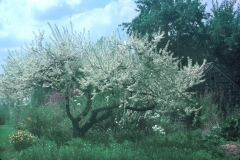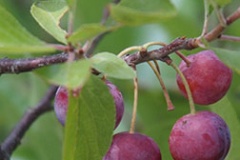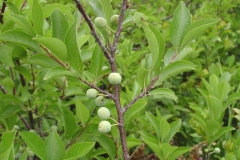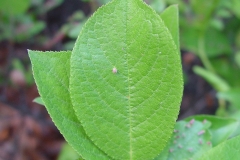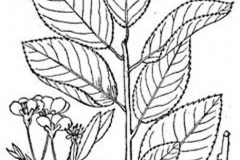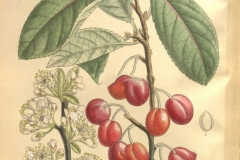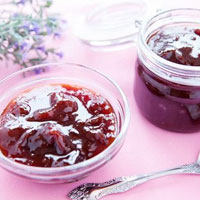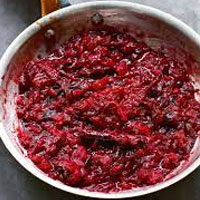| Beach Plum Quick Facts | |
|---|---|
| Name: | Beach Plum |
| Scientific Name: | Prunus maritima |
| Origin | Mid-Atlantic coastal region occurring as far north as the Canadian Maritime Provinces and south to northern Virginia |
| Colors | Ranges in color from a red to bluish purple to dark purple. |
| Shapes | Small spherical cherry shaped edible fruit which measures 0.5-1 in (1.5-2.5 cm) in diameter |
| Taste | Varies greatly from naturally sweet to tart or bitter |
| Health benefits | Alzheimer's disease, Parkinson's diseases, common cold, flu, heart diseases, diabetes and obesity |
| Name | Beach Plum |
|---|---|
| Scientific Name | Prunus maritima |
| Native | Mid-Atlantic coastal region occurring as far north as the Canadian Maritime Provinces and south to northern Virginia |
| Common Names | Beach plum, seaside plum, sand plum, Graves’ plum, Shore plum, Graves’ beach plum, American plum |
| Name in Other Languages | Afrikaans: Strand pruim Albanian: Kumbull plazhi Amharic: Yebahiri daricha pilemi (የባህር ዳርቻ ፕለም) Arabic: Albarquq alshshati (البرقوق الشاطئ), khukh bahriun (خوخ بحري) Armenian: Loghap’ salor (լողափ սալոր) Azerbaijani: Cimərlik gavalı Bengali: Saikata bara I (সৈকত বরই) Bulgarian: Plazhna sliva (плажна слива), morska sliva (морска слива) Burmese: Kamhkyay jee see (ကမ်းခြေဇီးသီး) Chinese: Hǎitān méi (海滩梅), Hǎibīn lǐ (海濱李) Croatian: Plava šljiva Czech: Plážová švestka, Švestkovišeň pomořská Danish: Strand blomme Dutch: Strand pruim English: Beach plum, Shore plum, Graves’ beach plum, Graves’ plum, American plum Esperanto: Strando pruno Estonian: Ranna ploom Filipino: Beach plum Finnish: Ranta luumu French: Prune de plage, Prunier des grèves Georgian: P’lazhis kliavi (პლაჟის ქლიავი) German: Strandpflaume Greek: Damáskino stin paralía (δαμάσκηνο στην παραλία) Gujarati: Bīca plama (બીચ પ્લમ) Hausa: Bakin ruwa plum Hebrew: שזיף חוף Hindi: Samudr tat ka ber (समुद्र तट का बेर) Hungarian: Strand szilva Icelandic: Fjara plóma Indonesian: Plum pantai Irish: Pluma trá Italian: Prugna da spiaggia Japanese: Bīchipuramu (ビーチプラム) Javanese: Plum pantai Kannada: Bīc plam (ಬೀಚ್ ಪ್ಲಮ್) Kazakh: Jağajay qara örik (жағажай қара өрік) Korean: Haebyeon maehwa (해변 매화) Kurdish: Cira bilûrê Lao: Plum hadsai (Plum ຫາດຊາຍ) Latin: Prunus litore Latvian: Pludmales plūme Lithuanian: Paplūdimio slyva Macedonian: Sliva na plazha (слива на плажа) Malagasy: Morona amoron-dranomasina Malay: Plum pantai Malayalam: Bīcc plaṁ (ബീച്ച് പ്ലം) Maltese: Għanbaqar bajja Marathi: Beech plam (बीच प्लम) Mongolian: Naran sharlagyn chavga Nepali: Samudr tat plam (समुद्र तट प्लम) Norwegian: Strandplomme Oriya: ବେଳାଭୂମି Pashto: د ساحل بیرل Persian: آلو ساحل, پرونوس دریایی Polish: Sliwka plażowa Portuguese: Ameixa de praia Punjabi: Bīca palama (ਬੀਚ ਪਲੱਮ) Romanian: Prune de plajă Russian: Plyazhnaya sliva (пляжная слива), Sliva morskaya (Слива морская) Serbian: Plava šljiva (плава шљива) Sindhi: سمنڊ جو Sinhala: Bīc ugat pantiya (බීච් උගත් පන්තිය) Slovenian: Plažna sliva Spanish: Ciruela de playa Sudanese: Pantai pantai Swedish: Strand plommon Tajik: Olu sohil (олу соҳил) Tamil: Kaṭaṟkarai piḷam (கடற்கரை பிளம்) Telugu: Bīc plaṁ (బీచ్ ప్లం) Thai: Phlạm chāyh̄ād (พลัมชายหาด) Turkish: Plaj erik Ukrainian: Plyazhna sliva (пляжна слива) Urdu: بیچ بیر Uzbek: Plyaj olxo’ri Vietnamese: Mận bãi biển Welsh: Eirin traeth Zulu: Ibhishi iplamu |
| Plant Growth Habit | Low growing, densely branching, multi-stemmed flowering shrub |
| Growing Climates | Light gravelly or sandy soils near the coast, sand dunes, beaches, sandy fields, roadsides, coastal barrens, tidewater stream sides |
| Soil | Thrives in a well-drained moisture-retentive loamy soil, doing well on limestone. Prefers some lime in the soil but is likely to become chlorotic if too much lime is present |
| Plant Size | 1–2 m (40–80 inches) high, although it can grow larger, up to 4 m (160 inches or over 13 feet) tall, when cultivated in gardens |
| Bark | Immature beach plum bark is reddish brown and smooth with bands of lenticels arranged horizontally. As the shrub ages, the bark darkens and becomes rough. Newer growth and young twigs are also reddish brown and pubescent |
| Leaf | Leaves are alternate, elliptical, 3–7 cm (1.2–2.8 inches) long and 2–4 cm (0.8–1.6 inches) broad, with a sharply toothed margin. They are green on top and pale below, becoming showy red or orange in the autumn |
| Flowering season | Mid-May and June |
| Flower | Showy five petaled flowers measure 1–1.5 cm (0.4–0.6 inches) in diameter with long filaments and yellow anthers. Stalks and sepals of the flowers are hairy |
| Fruit Shape & Size | Small spherical cherry shaped edible fruit which measures 0.5-1 in (1.5-2.5 cm) in diameter |
| Fruit Color | Ranges in color from a red to bluish purple to dark purple |
| Fruit Skin | Tough and tannic to thin and inconspicuous |
| Seed | Single egg shaped, stone type seed |
| Taste | Varies greatly from naturally sweet to tart or bitter |
| Propagation | By seed |
| Season | August and early September |
Plant Description
Beach Plum is a low growing, densely branching, multi-stemmed flowering shrub that normally grows about 1–2 m (40–80 inches) high, although it can grow larger, up to 4 m (160 inches or over 13 feet) tall, when cultivated in gardens. The plant is found growing in light gravelly or sandy soils near the coast, sand dunes, beaches, sandy fields, roadsides, coastal barrens, tidewater stream sides. The plant thrives in a well-drained moisture-retentive loamy soil, doing well on limestone. It also prefers some lime in the soil but is likely to become chlorotic if too much lime is present. Bark of immature beach plum is reddish brown and smooth with bands of lenticels arranged horizontally. As the shrub ages, the bark darkens and becomes rough. Newer growth and young twigs are also reddish brown and pubescent
Leaves
An interesting feature of the plant is that leaves appear after the flowers. Leaves are 3–7 cm (1.2–2.8 inches) long and 2–4 cm (0.8–1.6 inches) broad, with a sharply toothed margin. Alternately arranged, elliptical, finely toothed, egg-shaped leaves are green on top and pale below, becoming showy red or orange in the autumn with acute tips. Glands are positioned near the base of the leaf.
Flowers
White flowers bloom singly, but mostly in small umbel-like clusters of two to three along the stems in April or May prior to leaf-out and persist as late as June. Showy five petaled flowers measure 1–1.5 cm (0.4–0.6 inches) in diameter with long filaments and yellow anthers. Stalks and sepals of the flowers are hairy. The immaculate white of the flowers develops a pinkish hue upon successful pollination usually achieved through the service of wild bees, but other pollinating insects may perform the task as well. A distinctive feature of the flowers is their long stamens, which end with sizeable yellow anthers.
Fruit
Fertile flowers are followed by small spherical cherry shaped edible fruit which measures 0.5-1 in (1.5-2.5 cm) in diameter and ripens from August through September. The glaucous fruit produced usually ranges in color from a red to bluish purple to dark purple. Although less common it may also be brick red or on rare occasions yellow. Fruit skin displays a great degree of variability; the skin may range from tough and tannic to thin and inconspicuous. The flavor of the fruit also varies greatly ranging from naturally sweet to tart or bitter. The fruits are drupes, containing a single egg shaped, and stone type seed. They can be turned into wines, jams, jellies or cordials.
Traditional uses and benefits of Beach Plum
- In small amounts this exceedingly poisonous compound encourages respiration, improves digestion and gives a sense of well-being.
- Extracts from the beach plum are known to combat obesity and various related problems.
- It has been known for a long time that eating any type of stone fruit provides the body with a number of bioactive compounds that can regulate the metabolism.
- Several phenolic compounds and flavonoids found in the fruit have an anti-inflammatory action and fight obesity by acting at a cellular level.
- In addition, many of the issues caused by obesity are decreased, like heart diseases, diabetes or very high levels of cholesterol in the blood.
- Besides being a strong antioxidant, vitamin C also boost the body’s immune reaction and counter common cold, flu and make the organism more resilient against a wide range of infections.
- Flavonoids in the juice were found to have an effect on the cognitive problems caused by aging.
- They combat the inflammation of the neural areas, which preserves the memory and logical thoughts.
- Eating beach plums continually protects from Alzheimer’s and Parkinson’s diseases and can improve the condition of people who already suffer from such neurodegenerative issues.
Culinary Uses
- Fruit can be consumed raw or cooked.
- Fruit can be eaten out of hand, used in pies, preserves etc. or be dried for later use.
- Seed can also be consumed raw or cooked.
- Do not eat the seed if it is too bitter.
- The species is grown commercially to make jam.
Beach Plum Jam
Ingredients
- 4 cups whole beach plums
- 4 cups granulated sugar
- 1 cup medium-bodied red wine, such as Merlot
Directions
- Put a porcelain or ceramic plate in the freezer to chill. Meanwhile, combine all ingredients in a 5- to 6-quart heavy-bottomed pot over medium-high heat.
- Bring to a simmer so that the plums release their juices. Let cook 5 more minutes. Then pour mixture into a strainer set over a bowl, and press on the solids to extract the juice and fruit.
- Return extract to heat and simmer, stirring often, 25 minutes.
- Reduce heat as needed to keep from boiling up. Remove the chilled plate from the freezer and spoon a small amount of jam onto it.
- It should thicken when it hits the cold.
- If it’s thick enough, stop there. If not, return the plate to the freezer and continue cooking the puree, checking it at 5-minute intervals, until it reaches the desired thickness (it should form a skin when chilled).
- Pour into hot, sterilized jars to within 1/4 inch of the top, adjust lids, and process in boiling water 5 minutes. Let cool at room temperature and check seals.
Beach Plum Cordial
Ingredients
- 2 cups of cleaned, unpitted beach plums
- 2 cups of granulated sugar
- 750 ml of good cognac (don’t overspend on this); stopper and save the bottle but do not clean the inside.
Directions
- In a glass container with a tight non-metal lid, dissolve the sugar in the cognac and add the fruit.
- Stir and set aside in a cool place.
- Stir daily until sugar disappears.
Beach Plum Chutney
Ingredients
- 1 cup pitted beach plums cut up or a cup of plum pulp
- 4-5 medium peaches or pears or apples (or a mixture), peeled and roughly chopped
- 1 medium orange, peeled and cut up
- 1/2 cup of a mixture of dried fruits (raisins, currants, etc.)
- 1 shallot, chopped
- 1 small clove of garlic, chopped
- 1 Tbsp. olive oil
- 3/4 to 1 cup sugar (or mixture dark brown and white sugar)
- 1/2 cup apple cider vinegar
- 1 teaspoon ginger powder
- 1 whole clove
- 1 teaspoon of grated nutmeg
- 1 teaspoon of salt to taste
Directions
- Have sterilized jars ready. They can be left in the hot water until needed.
- Heat olive oil in heavy non-reactive sauce pan, add shallots and garlic and cook over medium heat until tender, about 5 minutes. Add sugar and
- Vinegar and stir until sugar is dissolved.
- Add remaining ingredients and bring to a boil while stirring.
- Continue to stir, reduce heat and cook until thickened.
- Pour or spoon the hot mixture into the jars leaving at least 1/4 inch of headspace. Close the jars tightly, let them cool and then refrigerate.
Beach Plum Sorbet
Ingredients
- 2-1/2 cups of pitted beach plums
- 1 cup of water
- 1 cup of sugar
- 1-2 tsp. lemon juice
- 1 Tbsp. Beach Plum Cordial (optional)
- Pinch of salt
Directions
- Combine the sugar and water over heat until the sugar is dissolved.
- Add the salt, lemon juice, cordial and plums and heat, with stirring, until it bubbles.
- Turn down the heat and simmer for about 15 minutes or until the mixture thickens and the plums have broken down.
- CAREFULLY (mixture is hot!) puree in a blender one cup at a time.
- Put the cooled puree through a strainer pressing out the pulp, this will remove any remaining skins and make a smoother sorbet.
- Pour the puree into a flat container and freeze for one hour.
- Remove the container and beat the slushy puree with a whisk (or electric hand mixer) and return to freezer for one hour.
- Repeat this process 3 more times (4 hours total). Leave overnight in the freezer for a firmer sorbet.
Other Facts
- Green dye can be obtained from the leaves.
- Dark grey to green dye can be obtained from the fruit.
- Plants have extensive root systems and can be used for binding sand along the coast.
Precautions
- In small quantities, hydrogen cyanide has been shown to stimulate respiration and improve digestion, it is also claimed to be of benefit in the treatment of cancer.
- In larger concentrations, however, cyanide can cause gasping, weakness, excitement, pupil dilation, spasms, convulsions, coma and respiratory failure leading to death.
References:
https://www.itis.gov/servlet/SingleRpt/SingleRpt?search_topic=TSN&search_value=24790#null
https://npgsweb.ars-grin.gov/gringlobal/taxon/taxonomydetail?id=30039
https://pfaf.org/user/Plant.aspx?LatinName=Prunus+maritima
https://gd.eppo.int/taxon/PRNMR
http://www.theplantlist.org/tpl1.1/record/rjp-3725
https://gobotany.nativeplanttrust.org/species/prunus/maritima/
https://www.wildflower.org/plants/result.php?id_plant=PRMA2
https://en.wikipedia.org/wiki/Prunus_maritima
https://www.nrcs.usda.gov/Internet/FSE_PLANTMATERIALS/publications/njpmcpg13391.pdf
https://www.cabi.org/isc/datasheet/44315
http://luirig.altervista.org/schedenam/fnam.php?taxon=Prunus+maritima
https://www.inaturalist.org/guide_taxa/15700
https://plants.usda.gov/home/plantProfile?symbol=PRMA2



